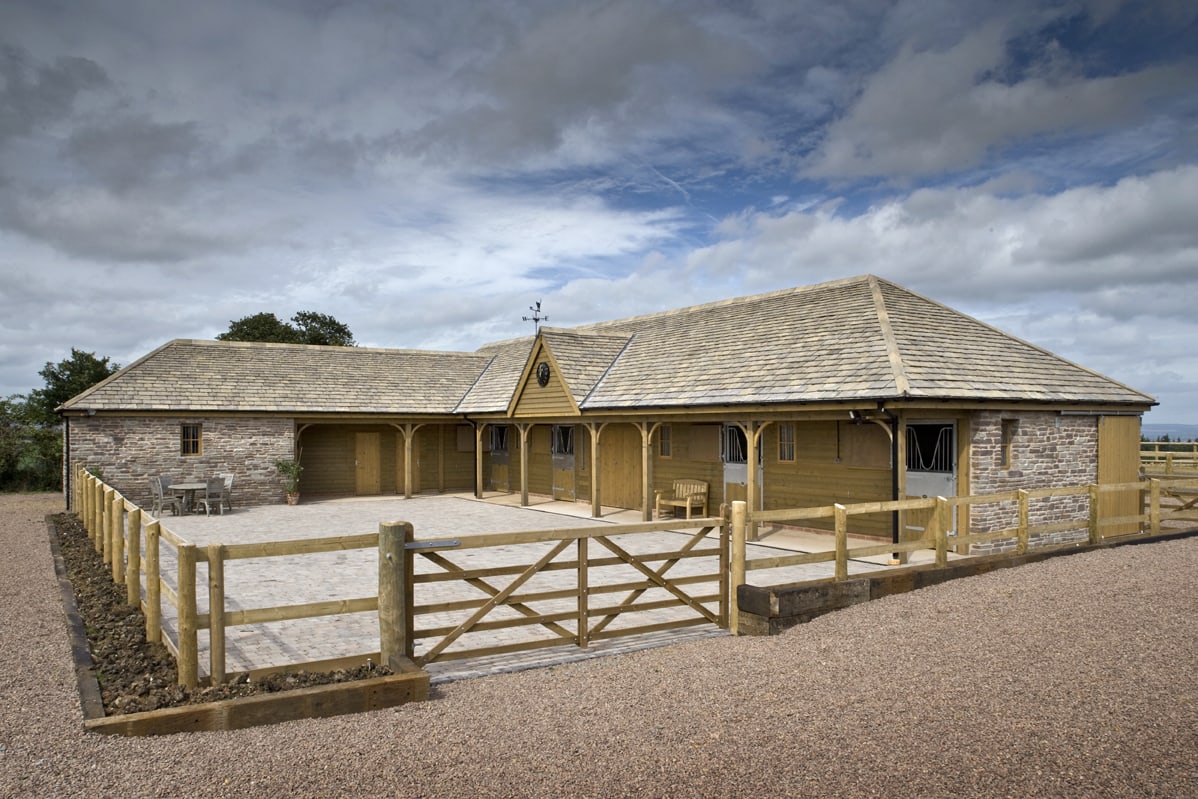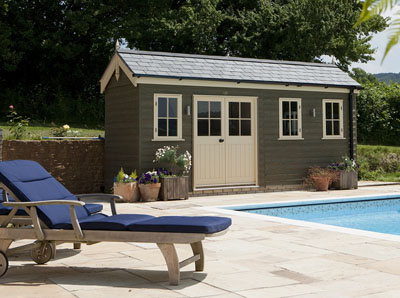We always remind our customers to think of their summerhouse as an integral part of their garden as well as a luxurious extension of their home. We find that this helps to focus the mind on decisions about the location and position of a new garden building, and how to set it off to best advantage.
In this blog we discuss landscaping and shaping your garden to accommodate your chosen summerhouse based on how you plan to use it, the style and size of your outdoor space, and the ideal type of foliage and planting to bring it to life within its own unique setting.
Why landscaping?
The 18th century landscape gardener Capability Brown worked with hundreds of country house owners to help them maximise their grounds by embracing the informality and exuberance of nature in contrast to the formal gardens and parterres of an earlier age. While you may not be commissioning a garden building for Highclere Castle, Blenheim Palace or Harewood House, it is always worth applying the principles of design, whether you are working with a rustic wilderness or a manicured lawn. First, choose a model of summerhouse that will complement your garden, and then go the extra mile to ensure that it fuses with its surroundings to create a unified effect.
Landscaping decisions are important for several aspects of your summerhouse plan.
You focus may be on landscaping for….
…Enjoying your favourite activities with ease
The area immediately around your garden building plays a key role providing access all year round and connecting you to the activities you enjoy. Link a swimming pool to your summerhouse with a robust timber or composite decking, sleek patio, or paving slabs and you can enjoy a dip in all weathers. Add subtle outdoor lighting around the pool area to create a stunning feature after dark and to augment your social gathering when the sun goes down.
If you plan to set up a home office in your garden, consider the impact on your lawn of beating a regular path to its door. Create a protective and attractive walkway that will help you wend your way to work each morning.
Landscaping your outdoor space with terracing, raised beds, and planters will level a sloping garden and provide a firm, solid base for your summerhouse. This can be achieved by creating a retaining wall using timber, reclaimed railway sleepers, dry stone or gabion, or brick and flint. There are hundreds of variations on garden terracing and this technique can add interest and drama while creating additional useful space in gardens of any size.
…Making the best use of outdoor space
Wherever you choose to position your summerhouse, it is worth looking at the options and not simply selecting the most obvious space or placing it on the same base as a previous outbuilding or shed. A premium hardwood summerhouse crafted with care and built to last represents a considerable step up from the average garden building and deserves a setting that will enable it to shine.
Position your summerhouse centrally with space all around, add a rotating base and you can enjoy a fresh perspective every day. To maintain as much lawn space as possible so that children can play or dogs can exercise, choose a position to the side or at the back of your garden, at an angle, or in a corner if your space is irregular. Scotts’ Newhaven corner summerhouse models are ideal for maximising an underused space and are ergonomically designed to fit in any garden.
Use your summerhouse to divide the landscape with lawn and planting on one side, and a vegetable patch or kitchen garden on the other.
…Introducing style and colour
Your summerhouse project means a great deal but don’t forget to have fun with your landscaping. Fire your imagination by reviewing the different colourways available from the Scotts’ range, augmented by fabric styles for seating and upholstery. With a bespoke summerhouse you can choose the size and shape and even specify the colour for the paintwork.
If you seek to create a traditional style garden for a period property, you might prefer a classic octagonal summerhouse with leaded glass windows and brass ironmongery. To complement this, plant time-honoured favourites such as roses, dahlias, hollyhocks, snapdragons, chrysanthemums, marigolds, hyacinths, lilies, irises, and sweet peas. You may prefer a more contemporary sunroom with expansive clear windows and doors with satin chrome fittings, and tongue-and-groove effect lining painted in a neutral colour such as Putty, Duck Egg, or Wood Ash.
To complement a modern vibe, minimise the colour palette of your planting and choose only flowers with white blooms such as lily of the valley, Solomon’s seal, or clematis. Simplicity can also be achieved by planting grasses with silver and gold tones that create interest and texture as they shimmer in the breeze.
Commentators are highlighting the trend for colourful palettes and striking tones. Mediterranean-style planting has become a popular trend. Choose plants that thrive in well-drained soil using gravel mulch to help protect them if your garden is boggy. Ideal varieties include lavender, and herbs such as thyme, rosemary, and verbena.
Create colour accents in complementary colours if you are planning a summerhouse with a painted finish. For example, in Scotts’ range, our Forest Green, Sage and Teal exteriors look stunning when highlighted by the shades of red that can be achieved by planting bergamot, dahlias, roses, salvias, peonies and dianthus.
An Aegean Blue garden building is beautifully brought to life by intense yellow daffodils, irises, begonias, and sunflowers. An orange pop of colour perfectly complements an Aubergine-painted summerhouse. To achieve a striking effect, plant marigolds, torch lily, milkweed, day lily or chrysanthemum.
…Framing the perfect view
Take a photographer’s perspective to the landscaping of your summerhouse and think about the views you will see from its windows, looking back towards your property, into your garden, and away to the horizon.
If you’re lucky enough to have garden overlooking fields and hills, a river, or the sea, make sure that your summerhouse is located so you can sit back, relax, and enjoy the vista before you. This may require the addition of decking, a patio, steps or terracing to get you into the right position. You may wish to frame the view by adding a pergola in front of your summerhouse and planting creepers such as honeysuckle, jasmine, ivy, or a climbing rose.
…Sheltering from the elements
Whether your summerhouse is installed at the top of a slope, or your garden is located in an exposed rural area, you will want to make sure that you can enjoy it all year round. Consider positioning it alongside a fence, hedge or bushes that could function as a windbreak.
You can construct a safe haven for your summerhouse by tucking it away in a secluded corner. Again, a rotating base option will enable you to turn away from the wind and rain when the weather is inclement. It’s usually best to avoid placing a summerhouse beneath trees as falling branches and debris could damage the roof. They can also restrict the light inside your garden building.
…Protecting nature and biodiversity
The addition of a summerhouse can be the perfect opportunity to renew your relationship with nature. The UK has lost around half of its wildlife and plant species over the last 50 years and is in the bottom 10 per cent of nations globally. More naturalistic garden styles can help ‘re-wilding’ and promote the survival of butterflies and insects on which the food chain relies.
Perhaps you could incorporate a wildflower meadow and even allow some stinging nettles to grow as these provide an important food source for some butterfly species. If you prefer a more traditional garden ambience, plant as many fragrant flowers as you have room for, to attract the bees. Layer your planting in descending height to maximise use of space and allow all varieties to thrive.
Your summerhouse could become a focal point for the division between your formal garden and the wilder, more natural aspect of your outdoor space. Position your garden hideaway with a view of both areas will enable you to watch varied species of birds and insects from our garden building as they make a home in a habitat that you have specially created. You can always include a sedum or green roof to create a natural looking and eco-friendly finish.
The outdoor walls of your summerhouse could offer the prefect place to position a bug hotel for solitary bees, a nest box or feeding station to attract colourful garden birds. If you are a keen twitcher, place the feeders where you can keep an eye on them through your binoculars from inside your summerhouse and watch the birds all year round in warmth and comfort.
Reach out and we will dig in to help
We hope that we have helped to inspire you with our pointers on landscaping for your garden building project. While not everyone needs the assistance of a Capability Brown, our team is always happy to discuss your ideas, provide precise dimensions and talk about the best sizes and shapes of summerhouse to complement your unique garden space.
Contact us for an informal chat and we will be delighted to assist you.










